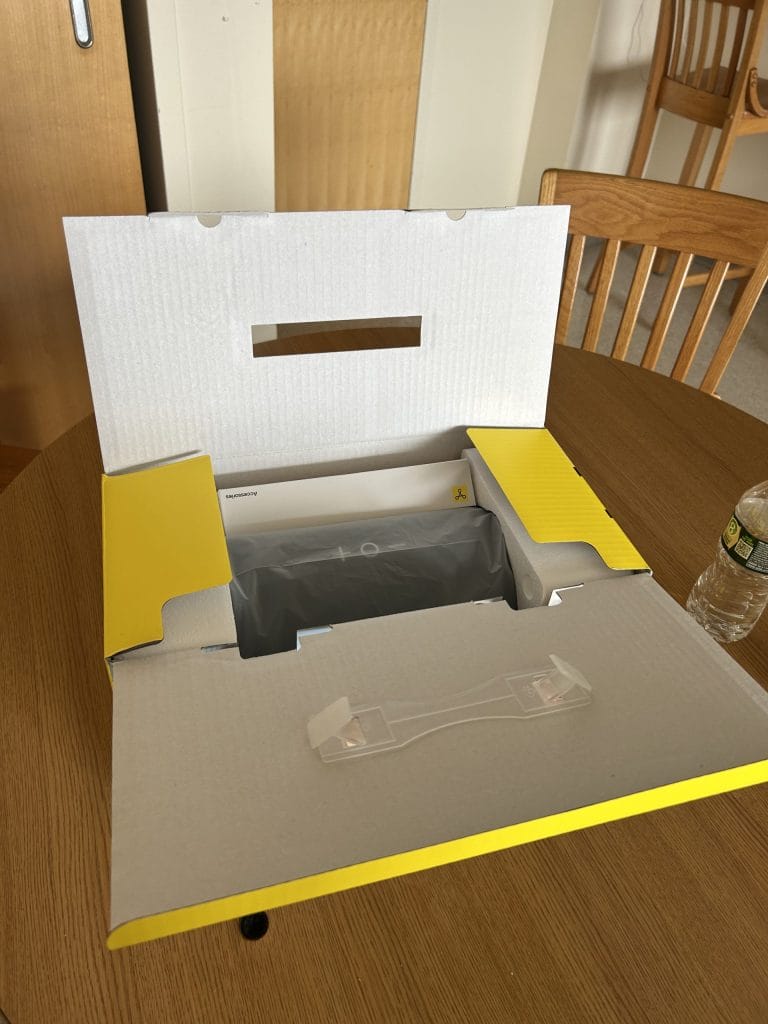Table of Contents
I love portable speakers. Being able to bring a speaker with me to a gathering with some friends is an instant way to turn a good hangout into a great one. Good people, good music, good times. And, it helps if the speaker itself is pretty good, too.
I recently got my hands on a TRIBIT StormBox Lava. One of the newest additions to the TRIBIT family, the StormBox Lava is a portable, pill-shaped speaker that comes with quite a few nifty features. According to the TRIBIT website, this thing has an 80W output power and can play frequencies as low as 43 hertz. This means only one thing: insane bass.
It’s also a surprisingly technical machine, using a TI amplifier chip and Bluetooth 5.4 to ensure seamless and stable connection. The last thing I’d want to do if I was on aux was accidentally cut out the music, so it’s good to hear they’ve taken the connection seriously. And, to add onto that, it’s waterproof and dustproof. If all of this is as good as it sounds, this may be a one-in-a-lifetime speaker.
Needless to say, when I opened it up, I was excited to try it out. I’ve never actually owned a speaker like this before, so here is my honest review
Setup
When you open the box, you’re greeted with the speaker and a small white cardboard box that contains the accessories. It’s held firmly in place by foam, so there is no need to worry about it getting damaged in transit. A good start, for sure.
Gotta admit, it’s a little bigger than I expected for a portable speaker. I’d say this is about 1.5x the size of your usual portable pill speaker. Not saying that’s a bad thing, but bigger isn’t always better when you want to bring something around with you. That said, it is extremely lightweight, which is a pleasant surprise.
Once you take it out of the box, it’s as simple as hitting the power button on the top to turn it on, and hitting the Bluetooth button to connect it to your device. It showed up instantly for me as “TRIBIT StormBox Lava” when I opened the Bluetooth screen on my iPhone.
Less than a second later, they were connected. It was nearly instantaneous.
After that, I took at look at everything else the speaker came with before testing it out.
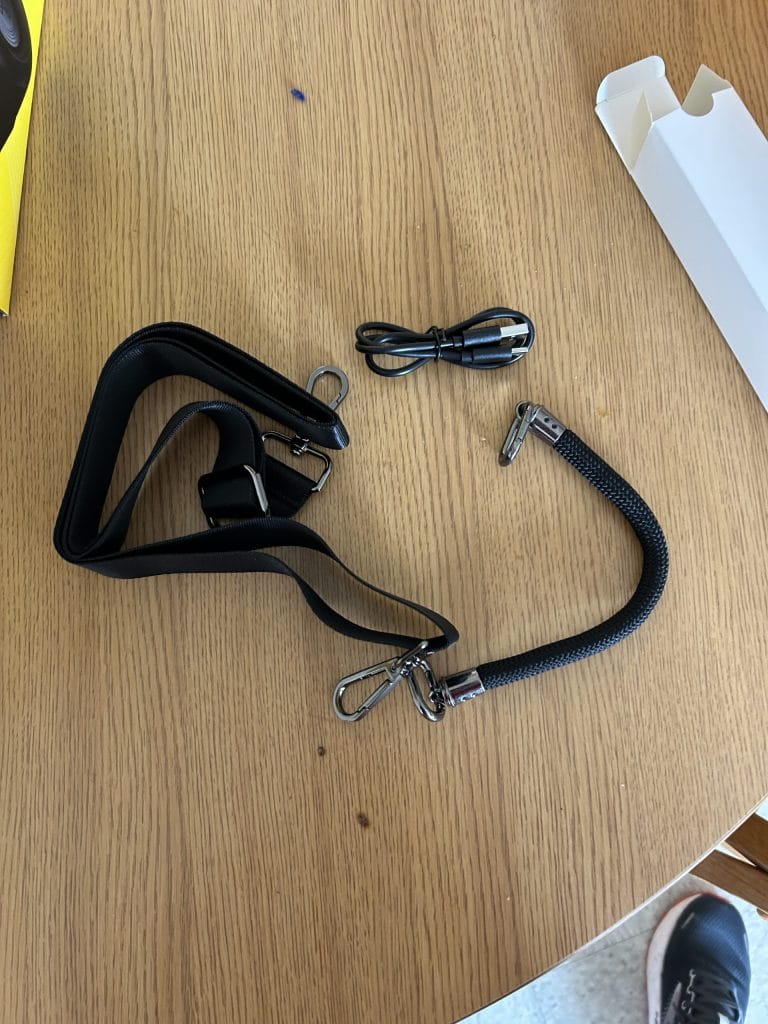
These are the accessories I mentioned earlier. It includes a shoulder strap, a handle, and a charging cable. The shoulder strap and handle are both strong and the carabiners at each end connect easily to the metal hoops on the top of the speaker. This is where the portability comes in; the handle and strap make it so easy to carry around on your shoulder or in your hand.
The charging cable is your traditional USB-A to USB-C cable. The USB-C is what plugs into the speaker to charge it, while the USB-A plugs into a socket. You’ll definitely have to want to have a wall plug that connects to a USB-A at the ready, as the speaker doesn’t come with one.
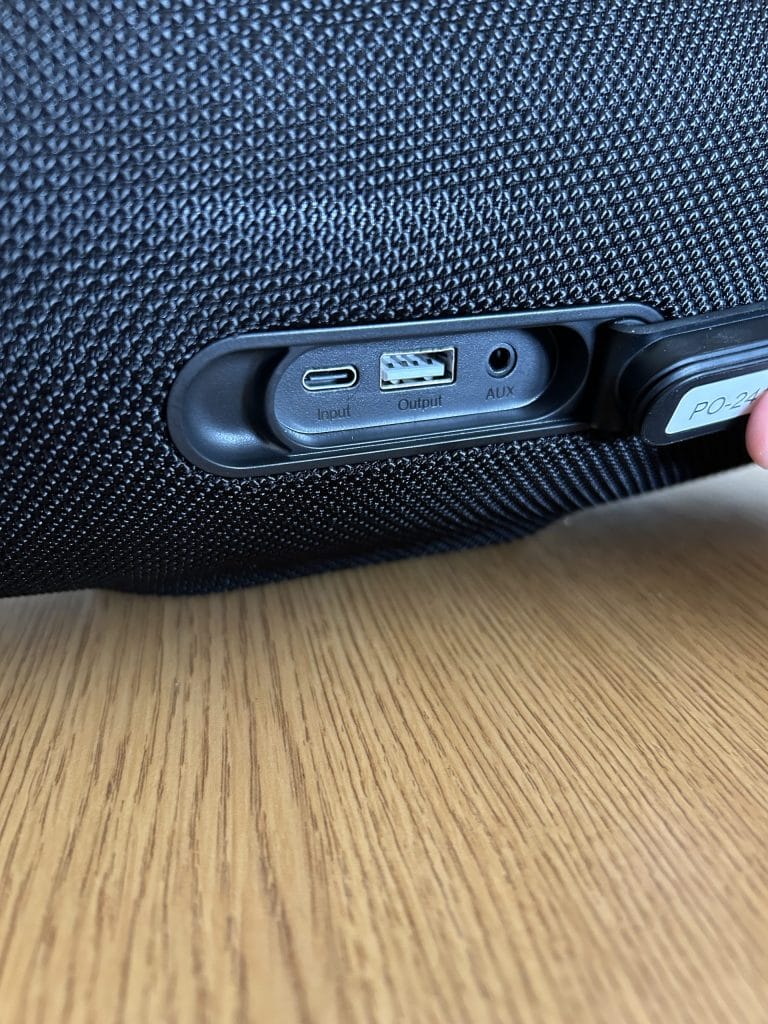
What’s cool is that you can actually use the charging cable to charge your phone, as well. As you can see, there’s a USB-A port on the actual speaker, which you can plug into with the charging cable, and can then plug in the USB-C to your phone. Unfortunately, my phone is an older model, so I wasn’t able to plug mine in.
However, it will work with the latest iPhones, as well as any device that uses USB-C as its connection. For example, it could charge my laptop. And, in case you were wondering, you can use any USB-C cable to charge the speaker; it doesn’t just have to be the one that they send.
There’s also an auxiliary port you can use to play music through the speaker in case you don’t want to use Bluetooth. But, I doubt you’ll need that if you’re using Bluetooth, as it connects to your phone automatically when you turn it on. It’s seriously the quickest Bluetooth connection I’ve ever used.
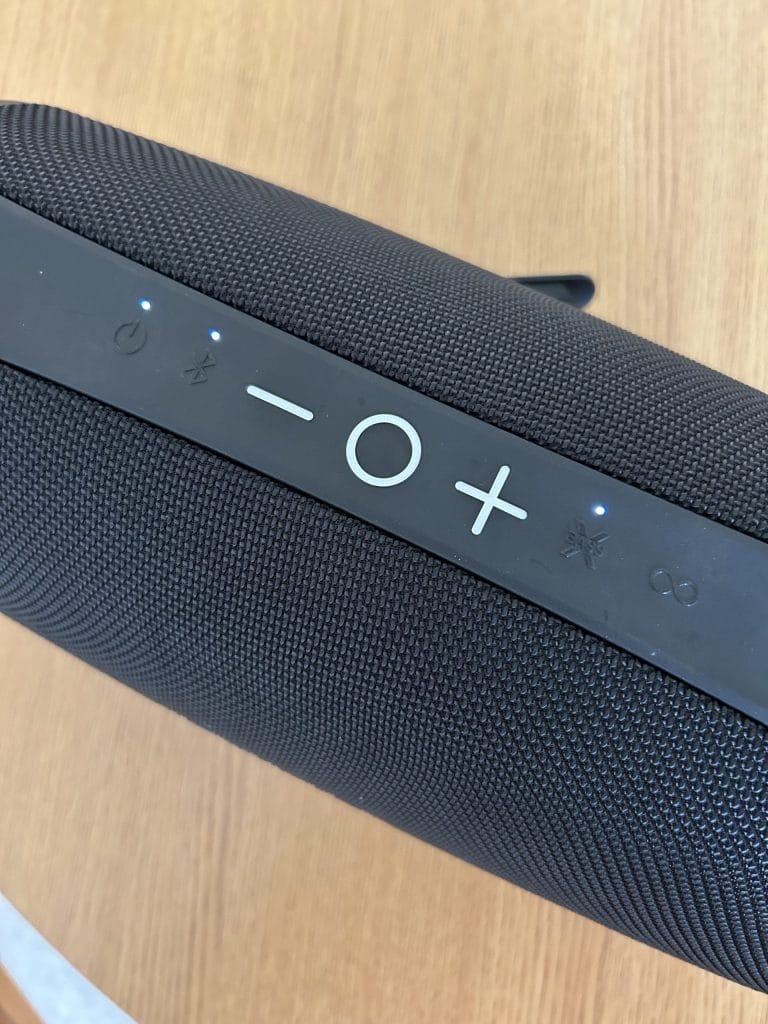
Lastly, let’s go through the buttons on the top. From left to right is the power button, which turns the speaker on, the Bluetooth button, which sets up a connection, the volume and play controls (the circle is the play and pause button), the bass booster, and the linking controls. I don’t have much use for the linking controls, but if you have several of these speakers, you can actually link them together using this button to play music at the exact same time; just be sure only one of the speakers is connected to your phone.
The bass booster does what you think it does. Hit it and the speaker will automatically boost your low end.
Lastly, before we get into usage, let’s go into the companion app.
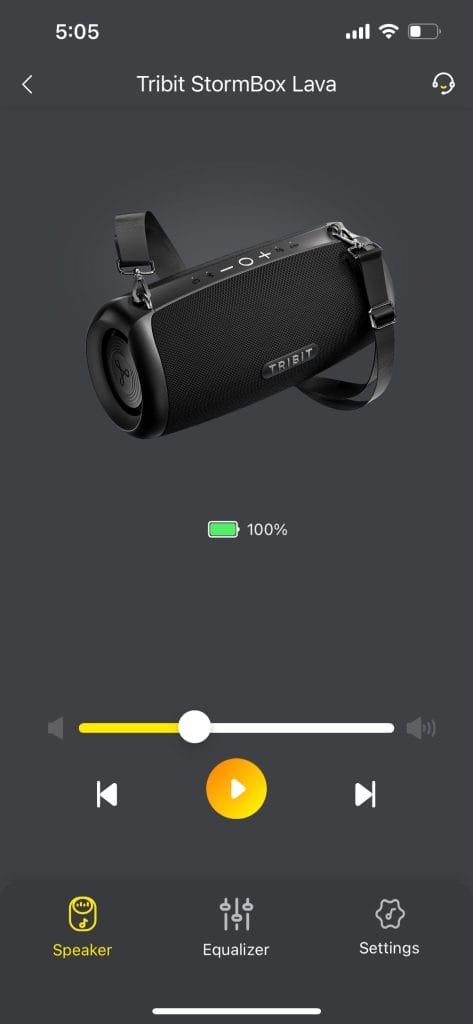
If your phone’s Bluetooth is connected to the speaker, it’ll automatically show up in the TRIBIT app. You can also adjust the volume from here. But, the most useful function of the app here is the equalizer, by far.
They’ve included several presets to apply to the speaker, including one specifically for jazz, one for classical, and, of course, the bass booster – hitting the bass booster button on the top actually just switches the output EQ to that one.
Oh, and if you want complete control over your sound, you can create your own EQ.

Sliding any of those nodes will make a frequency range louder or quieter, and you’ll be able to see what you’re doing on the visualizer on the top of the screen. There are many more nodes than there are in that picture. It’s a great feature for sure, and super easy and fun to use.
So, that’s about it for setup. From unboxing to usage, it took me about five minutes. It comes mostly charged, so you can use it right away.
Usage
If you promote an “explosive lava eruption sound”, I’m going to expect that. And, I very much got it. This thing can get LOUD. So, definitely be careful when using it!
Now that the loudness is out of the way, let’s talk about the sound quality. It’s phenomenal, specifically the bass. It’s clear a lot of work went into making sure that this speaker’s low end sounded as good as it could, and it does. You also get crisp highs and present midrange. It makes music sounds awesome.
I was worried that the bass booster would entirely blow out my speaker, but it actually makes everything sound better. It adds just a bit more presence and warmth to the low end, and is totally worth using. I actually think I like the speaker with the bass booster on more than I do with it on its normal setting!
There is also no latency whatsoever when you play something. The connection is seriously impressive; out of all Bluetooth devices that I’ve used, this is by far the best one. I also made sure that I could walk around my entire apartment without disconnecting from the speaker – I live in a fairly normal sized apartment at the moment, and I had no connection issues from anywhere.
I’m happy to confirm that, overall, I had absolutely no issues with how this speaker sounds and works. But, for what it’s worth, I was only listening by myself in my room while writing this first part. And, I know very well that’s not the point of this speaker. It’s begging to be brought to a gathering and used to play music for everyone there.
So, that’s exactly what I did. I invited some friends over, put some tunes on, and used this speaker the way it was meant to be used.
How It Went
The speaker was great in practice. Because the sound quality is so strong, you’re able to hear most every aspect of every song even when people are chatting.
I also got a lot of compliments on how it looked – indeed, it is a cool looking speaker, and I guess your friends will think you’re about 15% cooler if you have one. That’s a joke, but everyone was impressed by it.
I tested many different genres of music on it, from melodic house to indie pop to trap & hip hop. Everything sounded as good as it could have; specifically, listening to a rap song with intense 808s is a crazy experience with the bass boost on. I was really impressed by just how well it worked in practice.
Pros & Cons
Pros:
It sounds amazing.
A speaker’s job is to play music. I don’t care if it’s the coolest looking speaker in the world or boasts both Bluetooth and auxiliary audio functions, I need it to play music and make that music sound good. This speaker does that. While I don’t have a lot of experience with portable speakers, a lot of my friends do, and they said that it was a lot better than other portable speakers they’ve used.
Lightning-fast connection.
The Bluetooth capabilities on this thing seriously blow me away. The connection is instant, every single time. That, with the added bonus of an auxiliary option and the ability to simultaneously connect up to 100 of these speakers at once, makes this one of the top reasons why I love this speaker.
Flexible EQ.
While I did play around with the EQ settings and found that I just preferred the normal setting, it does offer quite a bit of flexibility for those of you who want to sculpt the sound coming from the speaker.
Cons:
The charging cable they provide is WAY too short.
It’s about a 6-inch cable. It’s not long enough at all. I found myself struggling to plug the speaker into the wall without having to dangle it from midair. Luckily, any USB-C cable can charge it. I plan on just leaving the cable in storage and using my laptop charger to charge the speaker.
I’m not sure I’d call it portable.
You can definitely carry it around, and the shoulder straps do help, but it is a little larger than I’d expect a portable speaker to be. It’s a nitpick for sure, but still. It’s also way more expensive than your average portable speaker, retailing at $129 USD. But, you do get your money’s worth.
Conclusion: Should you get it?
If you care about how music sounds coming out of your speakers, ultra-fast and reliable connection, and have the money, then I’d recommend grabbing the TRIBIT StormBox Lava if you are in the market for a portable Bluetooth speaker. I think you’ll have a great time with it, just as I’ve had thus far.
Buy the TRIBIT StormBox Lava here.
The post TRIBIT StormBox Lava Review: A Powerhouse of a Portable-ish Speaker appeared first on Magnetic Magazine.






